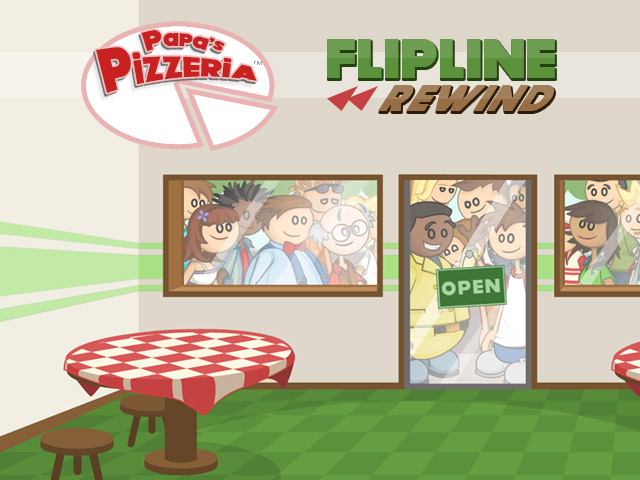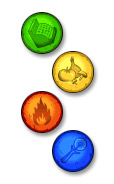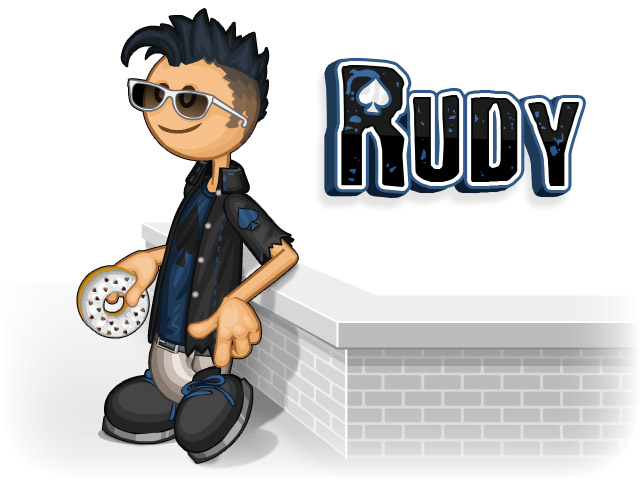Foodini’s Friday Games!
|
|
|||
|
|||
|
|||
![]()
|
|
|
|
|||
|
|||
|
|||
![]()

After finishing our first proper game “Papa Louie” in 2006, we wanted to use the same characters and universe that we established in that game and branch out into making other types of games. Instead of focusing on Papa Louie, we were curious what would be happening at the pizzeria while he was off on his adventures, and imagined that “Delivery Boy” Roy would get promoted and have to run the pizzeria all by himself. We had multiple options of how we could turn this into a game, but we were interested in if we could somehow create hands-on gameplay of carefully building pizzas, and blend that with a time-management game where you would have to keep juggling different tasks at the same time.
The final product ended up defining an entire series of games for us, and there were a handful of reasons why the game worked well and was popular with its fans. There were also a variety of problems that impacted the gameplay or made things too confusing for players, which we’ve tried to fix in later games in the series.
Even though Roy started as a delivery boy, we wanted him to step into the kitchen and run the entire pizzeria for this new game, and we needed a way for players to help Roy in his new job. Instead of one-click operations like other time-management games, we decided each part of the game would involve hands-on gameplay that would grade you on how you perform each task. We focused on ways to turn each task into mouse-based actions that involved either some degree of skill (like dragging a dotted line at just the right angle for cutting the pizza) or some amount of planning and arrangement (like placing the correct amount of toppings on the correct section of the pizza.)
This type of hands-on pizza crafting was unique to Papa’s Pizzeria when it was released, and offered an experience that just wasn’t found in other restaurant games.

It was the first time we had faced the challenge of designing a “restaurant game”, and we had to find the right balance between those two elements — keeping the hands-on nature of food prep in a restaurant feeling realistic, but also sacrificing realism when needed so it was still fun to play as a game.
We knew we wanted multitasking and the hectic feeling that brings, and we wanted the player to be involved in each step as much as possible. We’re always disappointed with food games where you click a button and a pizza is automatically topped with pepperoni perfectly, so we knew that individually placing each item was going to be a part of the game. Instead of order tickets magically appearing, we intentionally designed the game where Roy has to stop and take a customer’s order and wait for them to say what they want, while the clock is still running and pizzas are still cooking (and possibly burning unattended). That was a very real part of working solo in a pizzeria which made multitasking a challenge — both in real-life and in the game — and we thought it tied in well with our focus on time-management.
Along the way we had to take some liberties to make certain tasks more interesting or make things flow better as a game. Nobody orders a specific number of pepperoni on a specific quarter of a pizza in real-life, but this helped players understand how many toppings they should be using in that station, and challenged them to arrange the items just right. This extreme pickiness became a theme in all of the future Gamerias, with customers always being very particular about what they’re ordering. We also made some changes to the oven (real pizzas take much longer to cook of course) and with how many ways customers could ask for their pizza to be cooked. Most pizzerias can do regular and well-done pizzas at best, but the other time options added some more variety and more challenge to the oven, so players would have to keep an eye on tickets to know when each was ready. Also, most people wouldn’t stand around all day in the lobby waiting for their food to cook!
We constantly have to find just the right amount of realism in our Gamerias and know when to make changes for gameplay, but Papa’s Pizzeria proved we were on the right track and gave us a good idea of how to approach this in future games.

When we looked at other restaurant games, most had only a few graphics for the customers who visit the shop, so the restaurant would soon be filled with clones of the same three characters over and over. We’ve always been interested in developing unique characters, so we decided to go the extra mile with Papa’s Pizzeria and create an entire cast of customers who would visit.
We wanted players to connect with each customer as an individual character, so we started with giving each person a unique look and name, and had the game keep track of everyone who visits in a customer file rolodex. We also made certain to include and expand upon all the pixelated customers who appeared in Papa Louie. Instead of having customers order a random meal, we gave each customer a unique pizza that they always ordered as their favorite. Players could get used to these orders, and recognize and remember them as the customers come in and keep asking for the same thing, helping players make a stronger connection with these characters.
In later games we would sometimes remove some characters when we introduced new customers, but we’d often get complaints from players that their favorite customer was missing from a certain game. We now include the full lineup of customers in all of the newest Gamerias, so when players really get attached to a certain character, they can look forward to being reunited and serving them again in the next game.
 Most food games have you prepare one meal at a time, going through each step before moving on to the next and finishing the order. With Papa’s Pizzeria, we wanted to bring an element of realism to the restaurant, where one worker all by himself wouldn’t have the luxury of only doing one thing at a time. Roy would need to multitask to be able to handle topping, baking, cutting, and serving as the orders start piling up. We were confident we could make this work in a food game, offering up a challenge to players without getting unbearably frustrating. Seven years later, this element of multitasking is still one of the hallmarks of the Gameria series.
Most food games have you prepare one meal at a time, going through each step before moving on to the next and finishing the order. With Papa’s Pizzeria, we wanted to bring an element of realism to the restaurant, where one worker all by himself wouldn’t have the luxury of only doing one thing at a time. Roy would need to multitask to be able to handle topping, baking, cutting, and serving as the orders start piling up. We were confident we could make this work in a food game, offering up a challenge to players without getting unbearably frustrating. Seven years later, this element of multitasking is still one of the hallmarks of the Gameria series.
After working on “Rock Garden” as a paid downloadable casual game, we originally thought we would do the same for Papa’s Pizzeria, where players would buy the game and play it on their desktops. There were a handful of popular time-management games as paid downloads at the time, and the casual download market was much larger than it is now.
After having some success with “Papa Louie” as a web game and earning money from ad revenue, we decided to change our plans and try making Papa’s Pizzeria playable on the web and see if the same model would work for a time-management restaurant game. The game quickly became very popular once it was released, easily finding an audience since anyone could play it for free. In the end this was definitely the right decision for the game, and we were able to reach a wider fan-base (and earn more from ad revenue) than we could have done if it was a downloadable game.
In Papa’s Pizzeria, we thought of the side panel as the main interface for dealing with orders. You would need to drag a ticket onto that panel for buttons to appear in each station, and when you clicked the button to serve an order it would automatically serve it to whomever’s ticket was sitting on the side panel at that moment.
We didn’t explain the specifics of this during training, and while you’re busy multitasking on multiple orders it’s easy to mix up tickets and have the wrong ticket on the panel when you click to serve the pizza. Players would end up serving pizzas to the wrong customers, and didn’t realize why it was happening. We cleared this up in later Gamerias, but the system in Papa’s Pizzeria was much too confusing for players.
 One of the most common questions from players was what to do when a customer orders two pizzas. At first we didn’t understand why this would even be a question, since customers never order two pizzas at once! We eventually realized why players were confused: We never explained that multiple toppings on a ticket should all go on the same pizza.
One of the most common questions from players was what to do when a customer orders two pizzas. At first we didn’t understand why this would even be a question, since customers never order two pizzas at once! We eventually realized why players were confused: We never explained that multiple toppings on a ticket should all go on the same pizza.
During training, the first two orders only dealt with pepperoni as a single topping, so some players expected all pizzas to only have one topping. When customers started ordering multiple toppings, they thought each topping was supposed to go on its own separate pizza, and they didn’t understand what to do with those orders. We thought it was obvious that everything would go on the same pizza, but since training didn’t prepare them for this we could see why it could be confusing for some people. We learned our lesson from this, and in all of the later Gamerias, we make sure that training covers what to do with multiple ingredients.
We released Papa’s Pizzeria in August of 2007, and within a few months we noticed how popular the game had become both on our site and across the web. Around the same time, we had started on our large-scale MMO “Remnants of Skystone” for Kongregate, and with the scale and scope of that game we needed to work on it full-time until it was completed. We ended up working on Skystone for over two and a half years, and throughout that development period we didn’t have time to release any other games. Even though we knew that Papa’s Pizzeria was popular and that fans would love a sequel or spin-off, there was nothing we could do until our schedule was finally open again in 2010. When we finally released Papa’s Burgeria in late 2010, we were thrilled to find out the fans were still there, though we wished we could have followed up with a sequel earlier instead of having a three-year gap between the games.
 Instead of earning points for each meal served, we decided that customers would give Roy tips based on how well he had done. As Roy earned more tips, he would gradually level up and unlock more customers for the restaurant. This worked fine as a leveling system, but all of the focus on earning money made players disappointed that they couldn’t actually spend this money on anything in the game. Starting with Papa’s Burgeria, we added a separate tally of points that would determine leveling up, and added an in-game shop where players could spend their hard-earned tips on upgrades and lobby decorations. In newer games we’ve also added clothing that can be purchased with the players’ earned tips.
Instead of earning points for each meal served, we decided that customers would give Roy tips based on how well he had done. As Roy earned more tips, he would gradually level up and unlock more customers for the restaurant. This worked fine as a leveling system, but all of the focus on earning money made players disappointed that they couldn’t actually spend this money on anything in the game. Starting with Papa’s Burgeria, we added a separate tally of points that would determine leveling up, and added an in-game shop where players could spend their hard-earned tips on upgrades and lobby decorations. In newer games we’ve also added clothing that can be purchased with the players’ earned tips.
Beyond unlocking new customers and building pizzas, there weren’t a lot of additional features for players in Papa’s Pizzeria. At the time we weren’t even sure if players would be interested in a restaurant sim game, so we kept things simple and focused on the food preparation in the game. Since the release of Papa’s Pizzeria we’ve gradually added more and more features to each of the sequels, where players can now customize their experience with clothing and lobby decorations, play mini-games, design their own workers, unlock new ingredients, and celebrate holidays with unlockable ingredients and decorations. Papa’s Pizzeria feels a bit lacking today without all of these features, but it provided a great starting point to build on for the rest of the series.
Papa’s Pizzeria was the first in our series of restaurant games, and it helped define our unique brand of time-management games blended with hands-on food preparation. The gameplay and design proved to be popular and built a large fanbase craving more games in the series, and focusing on unique customers helped set us apart from other restaurant games. We learned from our mistakes in the first game to make the user interaction much clearer in the sequels, and by combining the original’s winning formula with an array of new features, we’ve built a series of games that are still enjoyed by millions today.
Hey Everyone!
For this week’s preview, we are revealing a new customer that will be making their debut in Papa’s Donuteria.
Ever since Scarlett’s Flipdeck, their has been tons of speculation that her boyfriend would be showing up in the next gameria. You guys guessed right and we are excited to introduce you to the newest customer, Rudy!!!

Finally, the full lineup for Scarlett and The Shakers will be in a game. Rudy will be visiting the restaurant once a week as a super picky Closer.
Check back each week for more news and previews of Papa’s Donuteria!